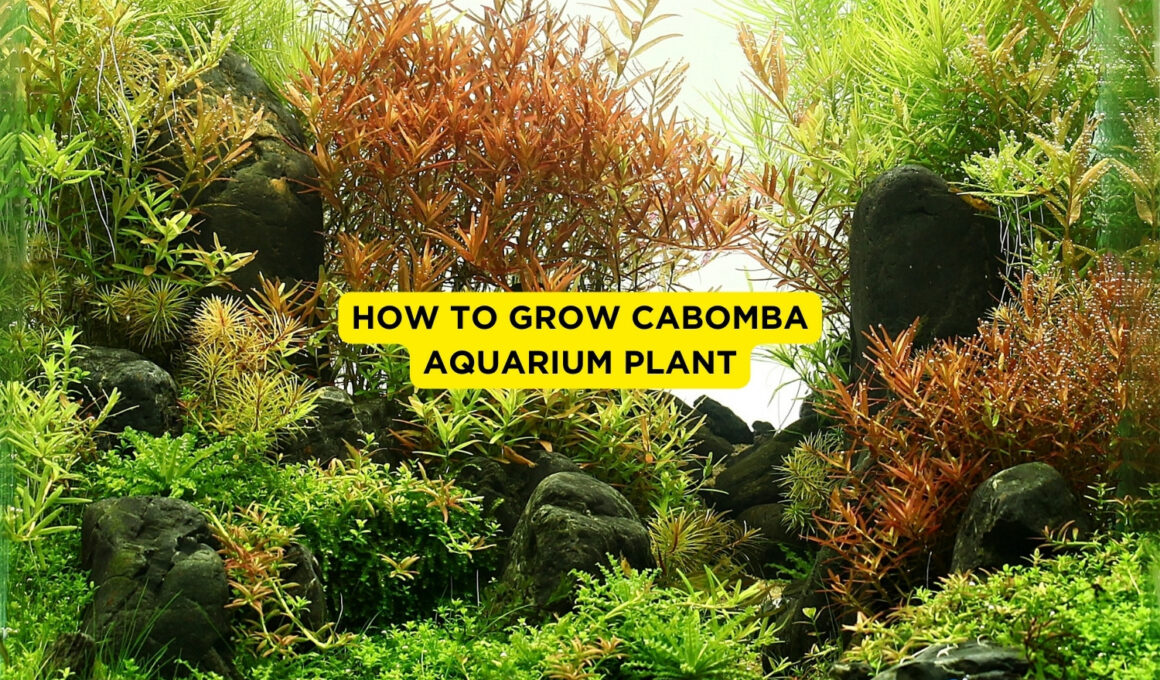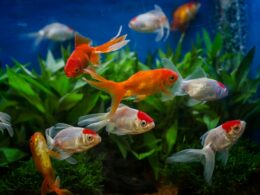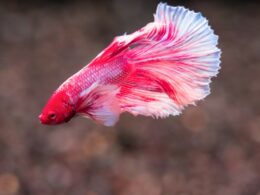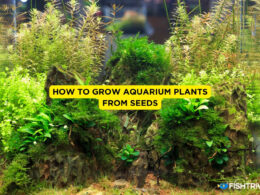In this article Show
Cabomba plants are becoming increasingly common among freshwater aquarium hobbyists. Green Cabomba, Carolina Fanwort, Brazilian Fanwort, or simply Fanwort are all common names for Cabomba plants.
Cabomba plants come in two colors: green and reddish-purple. Green Cabomba plants are the most common and widely available. Purple Cabomba, also known as Red Cabombas, is more uncommon.
Purple Cabomba and Red Cabomba are also known as Purple Fanwort and Red Fanwort, respectively. Cabomba plants make excellent context plants in the right tank conditions.
Cabomba (Cabomba Carolina), also known as fanwort, is a common aquatic plant in the hobby of aquarium keeping. It could apply to either the green or red Cabomba plant.
Green Cabomba is commonly available, while red (purple) Cabomba is uncommon and challenging to develop in a home aquarium. This article will show you how to grow the Cabomba Aquarium Plant and how to care for it. So, let’s get this started.
Also worth reading;
- How To Grow Aquarium Plants From Seeds
- How To Grow Water Sprite Aquarium Plant: Care Guide
- How to Plant Water Lily Bulbs in an Aquarium
- How To Clean Algae off Live Aquarium Plants: Step-by-Step Guide
What Is A Cabomba Aquarium Plant?
Cabomba is a genus of aquatic plants, one of two in the Cabombaceae family. It has fan-shaped submerged leaves and is common among aquarists as an ornamental and oxygenating plant for fish tanks.
Cabomba is a fast-growing, attractive-leaved water plant that is widely used in aquaria. The most popular and accessible aquarium subject is the green Cabomba (C. caroliniana). On the other hand, d Cabomba (C. furcata) is regarded as one of the most challenging aquarium plants to maintain.
Origins of Cabomba Plant
Cabomba aquatic plant is native to the southeastern United States, where it is considered a weed even in its native range.
It has become an invasive species in the western and northern United States due to the aquarium trade. It is of particular concern as an invasive species in Australia.
Cabomba is a versatile plant that can thrive in almost any area with slow-moving or stagnant water. Streams, rivers, wetlands, ditches, canals, and small lakes all have it. In the wild, it grows densely, crowding out other plants and even wildlife. This can happen in a home aquarium, so it’s essential to keep this plant trimmed regularly.
Cabomba Care
Green Cabomba care can be complex. Treatment for Red and Purple Cabombas is even more complicated.
Cabomba plants, therefore, may not be the best option for newcomers. This is particularly true if hobbyists are attempting to hold it in low-light, low-tech tanks.
Cabomba plants will look nice for a few days in low-light, low-tech tanks, but they soon disintegrate and die. Many new hobbyists use standard lighting hoods for their freshwater group tanks, but Green Cabomba plants deserve more.
Furthermore, the lighting specifications for Red Cabomba and Purple Cabomba are more strict than those for Green Cabomba. It is not as easy as having more low lighting for longer hours to satisfy the lighting requirements. Cabomba plants need more watts per gallon of light for extended periods.
In addition to adequate lighting, a Cabomba plant can need liquid fertilizer or root tabs to provide iron and other essential minerals. A Cabomba plant would benefit from CO2 supplements, though it is not needed.
Cabomba treatment is more complex than some of the other starter plants available, such as Anacharis, because of all of these problems.
Another aspect of Cabomba treatment to consider is which fish species it should hold this plant with. It is not recommended for cichlids, goldfish, or other roughens due to its fragility. Some Apple Snails may also be interested in consuming it.
Growth of Cabpmba Plant
1. Tank Size
Cabomba is suitable for small and large aquariums (e.g., 10-gallon or 40-liter).
2. Temperature, hardness, and pH of the water
Water Temperature: For this aquatic plant, a temperature range of 68 – 82 °F (20 – 28 °C) is ideal. Cabomba prefers water that is somewhat acidic to neutral in pH, ranging from 6.0 to 7.5. This showed the best growth in the experiments at pH 6.5.
3. Luminescence
Medium to high lighting is ideal for the plant’s development. Cabomba is known for its good coloration and rapid growth of shoots when exposed to bright light. Cabomba is unable to adapt to low-light environments. It will not grow well even in medium light if CO2 is not present.
It grows tall and leggy otherwise. Furthermore, these plants favor long photoperiods. Cabomba would do better as a floater than planted into the substrate if the light is not bright enough to satisfy its needs. It will get more light this way.
Prepare for algae bloom if you want to increase your light intensity but don’t want to go high-tech with CO2 injections. Light, CO2, and nutrients must all be balanced in high-tech tanks. There isn’t any other choice.
4. Substrate
Cabomba grows in loose substrates and does not root deeply in nature. It’s rare to come across it on cobblestones, sand, or even rock ledges. Cabomba absorbs nutrients from the water column, so it doesn’t matter what kind of substrate it’s growing on.
5. CO2 Dosing and Fertilization
A fertilizer application is also recommended. If you want your plants to be beautiful and safe, you should do it regularly. Cabomba is complicated to grow without the use of fertilizers.
It is not a root-feeder plant, even though it is often rooted. Cabomba is a water column feeder, so items like Seachem Excel can help it grow.
Plant Propagation Of Cabomba
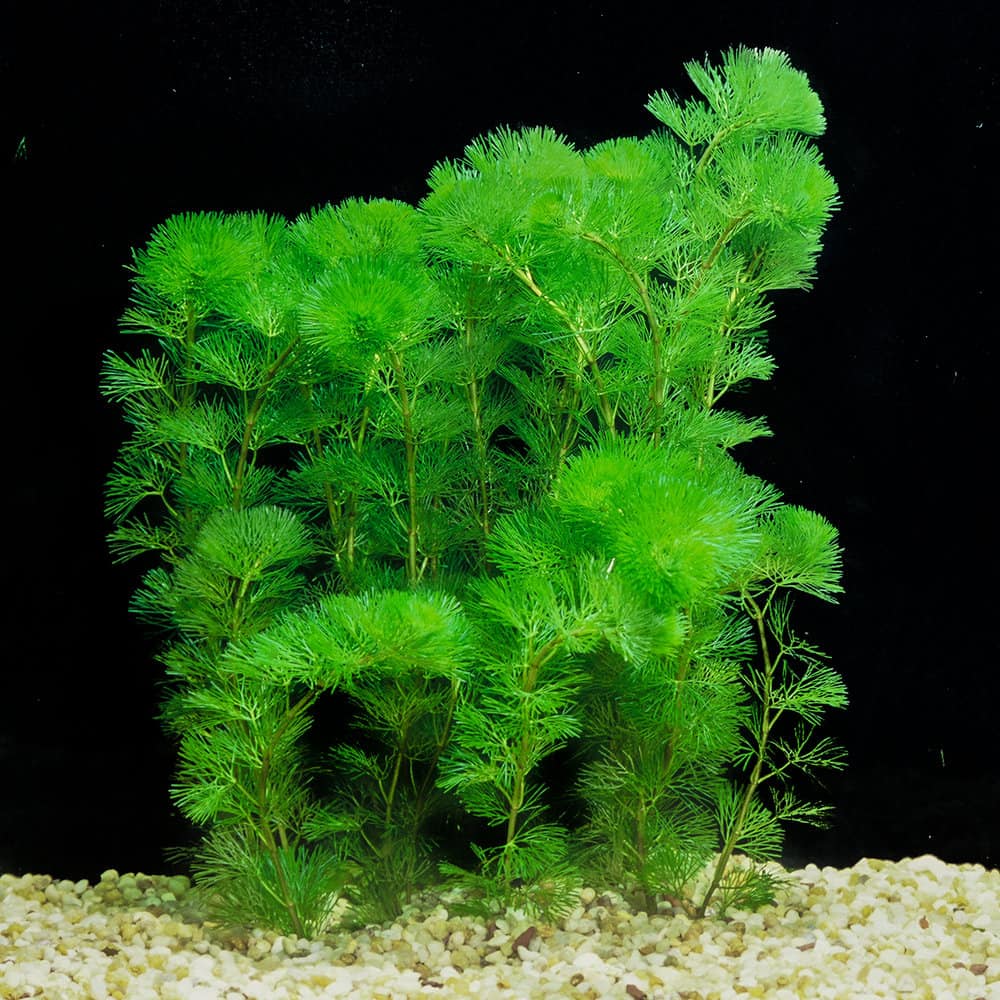
Cutting young branches from a mature Cabomba plant and pushing the trimmed stems at least an inch into the substrate is how the plant is propagated. Trim pieces that are 3 inches or longer when taking a cutting from the main plant, as the longer the stem, the faster it will establish.
However, starting new fanwort plants can be difficult, and the stems can often struggle to grow. As a result, make sure your cuttings receive plenty of light and are planted in a nutrient-rich substrate.
Your fanwort can overgrow if you give it the right conditions, so be prepared to prune it regularly. The key to trimming the stem is to gently do so gently, not split the plant or uproot it from the substrate.
After pruning, you have the choice of planting the cuttings, donating them to another aquarist through your nearby fish shop, or personally delivering them.
Cabomba Maintenance
Surprisingly, the aquarium trade often brands Cabomba as “easy to care for.” It will overgrow if you provide ideal conditions such as CO2, plenty of nutrients, and light. The issue is that building balanced high-tech planted tanks necessitates some awareness.
Cabomba needs many nutrients and light to survive and hold its vivid shoots; red in Cabomba Furcata, lime-green in Cabomba Caroliniana, and blue-green in Cabomba Aquatica. This plant needs a lot of light to grow, particularly if you want it to stay healthy and lush at all times.
If you want the proper colors to show, you can have at least 30 – 40 PAR of lighting for green-colored species and between 40 – 50 PAR for red/purple-colored species. Restricting nitrates is also a big help. As I previously said, the lights should be on for at least 10 hours per day.
Cabomba species can grow up to 1 inch (2.5 cm) per day once favorable growth conditions are present. This rapid growth rate will necessitate pruning regularly. Cabomba can grow up to the surface of aquariums if not pruned regularly.
Damaged or dead/decomposed leaves in the aquarium will clog the filter and degrade the water quality. They should be collected along with the trimmed overgrown shoots and disposed of properly.
Cabomba’s Advantages
Cabomba could be a good option for you if you want to make a jungle aquascape.
Cabomba can consume and use toxic chemicals such as nitrates, CO2, ammonia, and phosphates released from fish waste, decayed plant matter, and tap water as a fast-growing plant.
Cabomba is successful against algae and outcompetes it. It outcompetes algae for nutrients, slowing down their development. Fish, fry, and shrimp have a haven here, as well as invertebrates and small fish. Shrimp and fish enjoy it because it’s a great place to hide.
The foraging spot acts as a biofilm buffet, a portion of excellent first food for freshly hatched fry and shrimplets. Cabomba oxygenates and aerates the water in the tank.
Cabomba Plant Varieties
Cabomba plants come in two varieties: green or reddish-purple leaves, with the green variety being more popular and widely available.
1. Cabomba Verde
Cabomba Caroliniana var. Caroliniana, also known as green Cabomba or Carolina Cabomba, is a South and North American native to acidic lakes, wetlands, and rivers.
It has feathery, lime-green forked leaves with narrow segments that provide a fascinating texture that contrasts nicely with other aquatic plants and driftwood in the fish tank. Since green Cabomba grows densely, it’s perfect for aquascaping the backdrop of your planted aquarium.
2. Cabomba Rosa
Cabomba furcata ( Nectric Furcata), also known as red Cabomba, is a plant that grows in thick mats in soft acidic water and is native to Central and South America. The feathery lime-green to deep-red forked leaves of this fanwort variety are divided into narrow parts.
Red fanwort is best used as a backdrop plant in aquariums because it has vivid colors and exciting textures that stand out and contrast well with other plants and driftwood.
Frequently Asked Questions
Is soil needed for Cabomba?
Cabomba is propagated by cuttings that should be at least 2 inches long, though longer cuttings can develop themselves more quickly. Cuttings usually need a lot of light to root, and it should put them in a rich substrate.
What is the best way to propagate a Cabomba plant?
Cutting young branches from a mature Cabomba plant and pressing the trimmed stems at least an inch into the substrate is how it is propagated. Trim pieces that are 3 inches or longer when taking a cutting from the main plant, as the longer the stem, the faster it will establish.
Does Cabomba grow to be tall?
This plant comes in two LARGE bunches, each with six or more branches and standing six to eight inches tall. Purple Cabomba can reach nearly 2 feet tall with proper treatment and high-intensity lighting.
Can goldfish eat Cabomba?
Last but not least, Cabomba could be an excellent choice for your tank if you’re looking for a pretty, goldfish-friendly plant that doesn’t take much maintenance.
Conclusion
Cabomba is an excellent bunch plant to have in the context of your aquarium. It grows dense, beautiful vegetation that some fish species use for shade, hiding spots, and spawning activities.
The issue is that it’s one of those plants that either die quickly or grow into a weed in the tank. There’s nothing in the center.
Still, if you want to put your skills to the test, I suggest starting with the green Cabomba. In contrast to the Red Cabomba, which needs more care and attention, this plant is the least demanding and easiest to grow.






